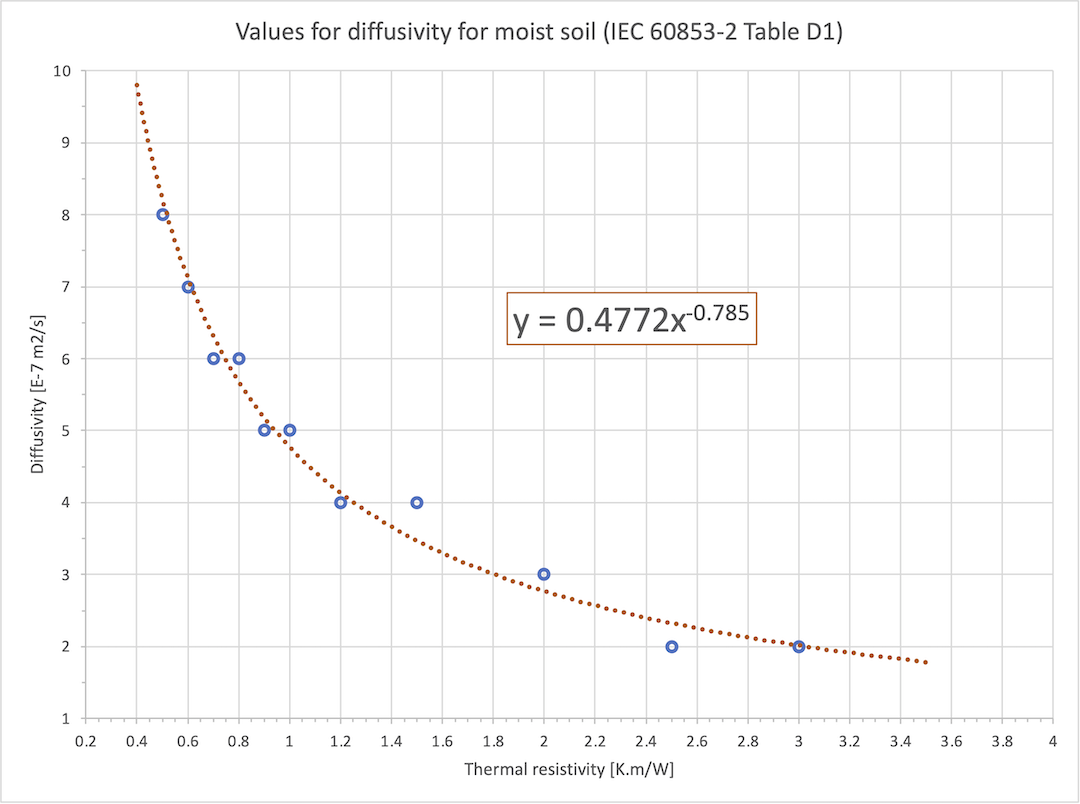The soil thermal diffusivity is the ratio of the thermal conductivity to the volumetric heat capacity. It is an indicator of the rate of at which a temperature change will be transmitted through the soil by conduction. When the thermal diffusivity is high, temperature changes are transmitted rapidly through the soil. Logically, soil thermal diffusivity is influenced by all the factors which influence thermal conductivity and heat capacity. Thermal diffusivity is somewhat less sensitive to soil water content than are thermal conductivity and volumetric heat capacity. The thermal diffusivity is a particularly useful parameter to aid in understanding and modeling soil temperatures.
For calculation of cyclic rating factors it is not necessary to accurately know the value of thermal diffusivity and it is generally satisfactory to use the tabulated functions given in the standard IEC 60853 which are based on the value of 5*10-7 m$^2$/s, and correspond roughly to a soil having a thermal resistivity of 1 K.m/W, and a moisture content of around 7% of dry weight.
There are currently five options to choose from to define the thermal diffusivity:
| $\frac{{10}^{-3}}{\rho_4 \zeta_{soil} \left(0.82+0.042\nu_{soil}\right)}$ | IEC 60853-2 eq. D-1 |
| $4.68{\cdot}{10}^{-7} \left(\frac{1}{\rho_4}\right)^{-0.8}$ | Li2005 / Neher1964 |
| $4.7717{\cdot}{10}^{-7} {\rho_4}^{-0.785}$ | IEC 60853-2 Table D1 optimal fit |
| $\frac{k_4}{\zeta_{soil} c_{p,soil}}$ | Related to density, heat capacity and conductivity |
| Value | diffusivity | resistivity | conductivity |
|---|---|---|---|
| 8e-07 | 8.0e-7 m²/s | 0.5 K.m/W | 2.00 W/(K.m) |
| 7e-07 | 7.0e-7 m²/s | 0.6 K.m/W | 1.67 W/(K.m) |
| 6.5e-07 | 6.5e-7 m²/s | 0.7 K.m/W | 1.43 W/(K.m) |
| 6e-07 | 6.0e-7 m²/s | 0.8 K.m/W | 1.25 W/(K.m) |
| 5.5e-07 | 5.5e-7 m²/s | 0.9 K.m/W | 1.11 W/(K.m) |
| 5e-07 | 5.0e-7 m²/s | 1.0 K.m/W | 1.00 W/(K.m) |
| 4.5e-07 | 4.5e-7 m²/s | 1.2 K.m/W | 0.83 W/(K.m) |
| 4e-07 | 4.0e-7 m²/s | 1.5 K.m/W | 0.67 W/(K.m) |
| 3e-07 | 3.0e-7 m²/s | 2.0 K.m/W | 0.50 W/(K.m) |
| 2.5e-07 | 2.5e-7 m²/s | 2.5 K.m/W | 0.40 W/(K.m) |
| 2e-07 | 2.0e-7 m²/s | 3.0 K.m/W | 0.33 W/(K.m) |
